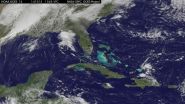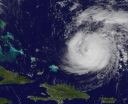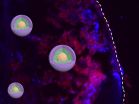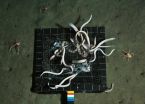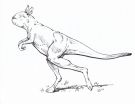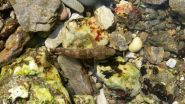Satellite eyes first major Atlantic Hurricane in 3 years: Gonzalo
2014-10-15
(Press-News.org) VIDEO:
This animation of visible and infrared images from NOAA's GOES-East satellite shows the movement and strengthening of Gonzalo from a tropical storm on Oct. 13 to a hurricane on Oct....
Click here for more information.
Hurricane Gonzalo has made the jump to major hurricane status and on Oct. 15 was a Category 4 storm on the Saffir-Simpson Hurricane Scale. NOAA's GOES-East satellite provided imagery of the storm. According to the National Hurricane Center, Gonzalo is the first category 4 hurricane in the Atlantic basin since Ophelia in 2011.
NOAA's GOES-East satellite provides visible and infrared images of weather from its orbit in a fixed position over the Earth. On Oct. 15 at 15:15 UTC (11:15 a.m. EDT) GOES saw Gonzalo had tightly wrapped bands of thunderstorms spiraling into the center of its circulation. The eye of the storm was obscured by high clouds in the image. NOAA aircraft data and microwave images clearly show concentric eyewalls, with the inner radius of maximum winds now only about 4-5 nautical miles from the center.
NOAA manages the GOES satellites, while NASA/NOAA's GOES Project at NASA's Goddard Space Flight Center in Greenbelt, Maryland created the image. The NASA/NOAA GOES Project creates images and animations from GOES data.
At 11 a.m. EDT on Oct. 15, Gonzalo's maximum sustained winds increased to near 130 mph (215 kph) and the National Hurricane Center (NHC) noted that fluctuations in intensity are expected over the next couple of days. Gonzalo's cloud-covered eye was located near latitude 23.5 north and longitude 68.0 west, about 640 miles (1,025 km) south-southwest of Bermuda. Gonzalo is moving toward the northwest near 12 mph (19 kph). The minimum central pressure recently reported by an air force reconnaissance aircraft was 949 millibars.
Tropical storm conditions are possible in Bermuda by late Thursday night, Oct. 16, and hurricane conditions are possible over Bermuda on Friday Oct. 16.
Ocean swells however, will be felt over a much larger area, reached the U.S. east coast on Oct. 16. Large swells generated by Gonzalo are affecting portions of the Virgin Islands, the northern coasts of Puerto Rico and the Dominican Republic and portions of the Bahamas. Swells will reach much of the east coast of the United States and Bermuda on Thursday.
By late Oct. 16, Gonzalo is expected to turn to the northeast and the center is expected to approach Bermuda sometime on Oct. 17.
INFORMATION:
Rob Gutro
NASA's Goddard Space Flight Center
ELSE PRESS RELEASES FROM THIS DATE:
2014-10-15
Nanomedicines consisting of nanoparticles for targeted drug delivery to specific tissues and cells offer new solutions for cancer diagnosis and therapy. Understanding the interdependency of physiochemical properties of nanomedicines, in correlation to their biological responses and functions, is crucial for their further development of as cancer-fighters.
"To develop next generation nanomedicines with superior anti-cancer attributes, we must understand the correlation between their physicochemical properties—specifically, particle size—and their interactions ...
2014-10-15
Researchers in Syracuse University's College of Arts and Sciences are pairing chemical analyses with micropaleontology—the study of tiny fossilized organisms—to better understand how global marine life was affected by a rapid warming event more than 55 million years ago.
Their findings are the subject of an article in the journal Paleoceanography (John Wiley & Sons, 2014).
"Global warming impacts marine life in complex ways, of which the loss of dissolved oxygen [a condition known as hypoxia] is a growing concern" says Zunli Lu, assistant professor of ...
2014-10-15
A new study using a reconstruction of North American drought history over the last 1,000 years found that the drought of 1934 was the driest and most widespread of the last millennium.
Using a tree-ring-based drought record from the years 1000 to 2005 and modern records, scientists from NASA and Lamont-Doherty Earth Observatory found the 1934 drought was 30 percent more severe than the runner-up drought (in 1580) and extended across 71.6 percent of western North America. For comparison, the average extent of the 2012 drought was 59.7 percent.
"It was the worst by a ...
2014-10-15
This week, researchers from University of Hawai'i, Norway, and the UK have shown with innovative experiments that a rise in jellyfish blooms near the ocean's surface may lead to jellyfish falls that are rapidly consumed by voracious deep-sea scavengers. Previous anecdotal studies suggested that deep-sea animals might avoid dead jellyfish, causing dead jellyfish from blooms to accumulate and undergo slow degradation by microbes, depleting oxygen at the seafloor and depriving fish and invertebrate scavengers, including commercially exploited species, of food.
Globally ...
2014-10-15
PROVIDENCE, R.I. [Brown University] — Imagine that a time machine has transported you to the Australian outback 100,000 years ago. As you emerge, you see a huge kangaroo with a round rabbit-like face foraging in a tall bush nearby. The animal's surprising size makes you gasp aloud but when it hears you, becoming equally unnerved, it doesn't hop or lumber away on all fours and tail like every kangaroo you've seen in the present. It walks on its feet. One at a time. Like you.
In a new paper in the journal PLoS ONE, a team of researchers led by Christine Janis, professor ...
2014-10-15
Now extinct giant kangaroos most likely could not hop and used a more rigid body posture to move their hindlimbs one at a time, according to a study published October 15, 2014 in the open-access journal PLOS ONE by Christine Janis from Brown University and colleagues.
The "short-faced," large-bodied sthenurine kangaroos–a now extinct relative to modern-day kangaroos–first appeared in the middle Miocene and became extinct in the late Pleistocene. The largest of these kangaroos had an estimated body mass of 240 kg, almost three times the size of the largest ...
2014-10-15
Turning the street lights off decreased the number of grounded fledglings, according to a study published October 15, 2014 in the open-access journal PLOS ONE by Airam Rodríguez and colleagues from Phillip Island Nature Parks, in Victoria, Australia, and Estación Biológica de Doñana, in Spain.
Thousands of birds are attracted to lights–sometimes referred to as light-pollution–every year worldwide during their first flights from their nests to the open ocean, a phenomenon called 'fallout.' Short-tailed shearwater breeding on the coast of ...
2014-10-15
People who risk their lives to save strangers may do so without deliberation, according to an analysis of statements from more than 50 recognized civilian heroes, conducted by David Rand from Yale University and colleagues published October 15, 2014 in the open access journal PLOS ONE.
Scientists studying human cooperation recruited hundreds of participants to rate 51 statements made during published interviews by recipients of the Carnegie Hero Medal, given to civilians who risk their lives to save strangers. Study participants as well as a computer text analysis algorithm ...
2014-10-15
Research from the University of Exeter has revealed that the rock goby (Gobius paganellus), an unassuming little fish commonly found in rock pools around Britain, southern Europe, and North Africa, is a master of camouflage and can rapidly change colour to conceal itself against its background.
Whether hiding from predators or from families hunting in rock pools, the rock goby can change both its colour and brightness to match its background in just one minute.
Dr Martin Stevens from the Centre for Ecology and Conservation at the University of Exeter's Penryn Campus ...
2014-10-15
An investigation into how patient outcomes are assessed in clinical trials has revealed a worrying lack of consistency, raising concerns about funding being wasted on the acquisition of poor quality data.
Information collected through clinical trials plays a crucial role in improving the standard of patient care. Patient Reported Outcomes (PROs) inform our understanding of how certain treatments and interventions work by evaluating their effectiveness, and any potential side effects, from the patient perspective.
Patients in trials are commonly invited to fill in questionnaires ...
LAST 30 PRESS RELEASES:
[Press-News.org] Satellite eyes first major Atlantic Hurricane in 3 years: Gonzalo

